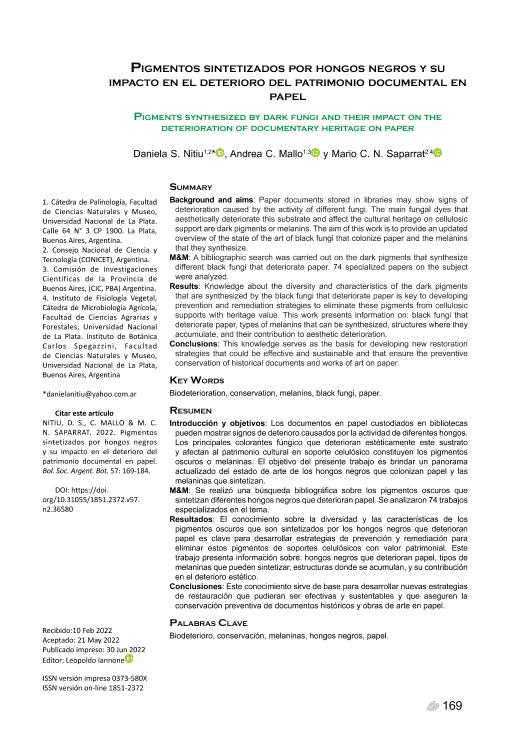Mostrar el registro sencillo del ítem
dc.contributor.author
Nitiu, Daniela Silvana

dc.contributor.author
Mallo, Andrea Cecilia

dc.contributor.author
Saparrat, Mario Carlos Nazareno

dc.date.available
2023-08-25T19:55:30Z
dc.date.issued
2022-06
dc.identifier.citation
Nitiu, Daniela Silvana; Mallo, Andrea Cecilia; Saparrat, Mario Carlos Nazareno; Pigmentos sintetizados por hongos negros y su impacto en el deterioro del patrimonio documental en papel; Sociedad Argentina de Botánica; Boletín de la Sociedad Argentina de Botánica; 57; 2; 6-2022; 169-184
dc.identifier.issn
0037-850X
dc.identifier.uri
http://hdl.handle.net/11336/209438
dc.description.abstract
Introducción y objetivos: Los documentos en papel custodiados en bibliotecas pueden mostrar signos de deterioro causados por la actividad de diferentes hongos. Los principales colorantes fúngico que deterioran estéticamente este sustrato y afectan al patrimonio cultural en soporte celulósico constituyen los pigmentos oscuros o melaninas. El objetivo del presente trabajo es brindar un panorama actualizado del estado de arte de los hongos negros que colonizan papel y las melaninas que sintetizan.M&M: Se realizó una búsqueda bibliográfica sobre los pigmentos oscuros que sintetizan diferentes hongos negros que deterioran papel. Se analizaron 74 trabajos especializados en el tema.Resultados: El conocimiento sobre la diversidad y las características de los pigmentos oscuros que son sintetizados por los hongos negros que deterioran papel es clave para desarrollar estrategias de prevención y remediación para eliminar estos pigmentos de soportes celulósicos con valor patrimonial. Este trabajo presenta información sobre: hongos negros que deterioran papel, tipos de melaninas que pueden sintetizar, estructuras donde se acumulan, y su contribución en el deterioro estético. Conclusiones: Este conocimiento sirve de base para desarrollar nuevas estrategias de restauración que pudieran ser efectivas y sustentables y que aseguren la conservación preventiva de documentos históricos y obras de arte en papel.
dc.description.abstract
Background and aims: Paper documents stored in libraries may show signs of deterioration caused by the activity of different fungi. The main fungal dyes that aesthetically deteriorate this substrate and affect the cultural heritage on cellulosic support are dark pigments or melanins. The aim of this work is to provide an updated overview of the state of the art of black fungi that colonize paper and the melanins that they synthesize. M&M: A bibliographic search was carried out on the dark pigments that synthesize different black fungi that deteriorate paper. 74 specialized papers on the subject were analyzed. Results: Knowledge about the diversity and characteristics of the dark pigments that are synthesized by the black fungi that deteriorate paper is key to developing prevention and remediation strategies to eliminate these pigments from cellulosic supports with heritage value. This work presents information on: black fungi that deteriorate paper, types of melanins that can be synthesized, structures where they accumulate, and their contribution to aesthetic deterioration. Conclusions: This knowledge serves as the basis for developing new restoration strategies that could be effective and sustainable and that ensure the preventive conservation of historical documents and works of art on paper.
dc.format
application/pdf
dc.language.iso
spa
dc.publisher
Sociedad Argentina de Botánica

dc.rights
info:eu-repo/semantics/openAccess
dc.rights.uri
https://creativecommons.org/licenses/by-nc-sa/2.5/ar/
dc.subject
BIODETERIORO
dc.subject
CONSERVACION
dc.subject
MELANINAS
dc.subject
HONGOS NEGROS
dc.subject
PAPEL
dc.subject.classification
Micología

dc.subject.classification
Ciencias Biológicas

dc.subject.classification
CIENCIAS NATURALES Y EXACTAS

dc.title
Pigmentos sintetizados por hongos negros y su impacto en el deterioro del patrimonio documental en papel
dc.title
Pigments synthesized by dark fungi and their impact on the deterioration of documentary heritage on paper
dc.type
info:eu-repo/semantics/article
dc.type
info:ar-repo/semantics/artículo
dc.type
info:eu-repo/semantics/publishedVersion
dc.date.updated
2023-07-07T21:26:57Z
dc.identifier.eissn
1851-2372
dc.journal.volume
57
dc.journal.number
2
dc.journal.pagination
169-184
dc.journal.pais
Argentina

dc.journal.ciudad
Ciudad Autónoma de Buenos Aires
dc.description.fil
Fil: Nitiu, Daniela Silvana. Consejo Nacional de Investigaciones Científicas y Técnicas. Centro Científico Tecnológico Conicet - La Plata; Argentina. Universidad Nacional de La Plata. Facultad de Ciencias Naturales y Museo. Cátedra de Palinología; Argentina
dc.description.fil
Fil: Mallo, Andrea Cecilia. Provincia de Buenos Aires. Gobernación. Comisión de Investigaciones Científicas; Argentina. Universidad Nacional de La Plata. Facultad de Ciencias Naturales y Museo. Cátedra de Palinología; Argentina
dc.description.fil
Fil: Saparrat, Mario Carlos Nazareno. Consejo Nacional de Investigaciones Científicas y Técnicas. Centro Científico Tecnológico Conicet - La Plata. Instituto de Fisiología Vegetal. Universidad Nacional de La Plata. Facultad de Ciencias Naturales y Museo. Instituto de Fisiología Vegetal; Argentina
dc.journal.title
Boletín de la Sociedad Argentina de Botánica

dc.relation.alternativeid
info:eu-repo/semantics/altIdentifier/url/https://revistas.unc.edu.ar/index.php/BSAB/article/view/36580
dc.relation.alternativeid
info:eu-repo/semantics/altIdentifier/doi/https://doi.org/10.31055/1851.2372.v57.n2.36580
Archivos asociados
